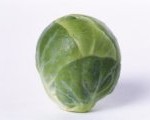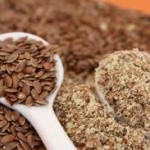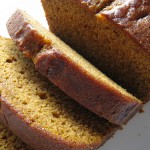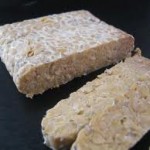 Named after the capital of Belgium, Brussels sprouts have a nutrient density that earns them a ranking in the “Vegetable Hall of Fame.” This cruciferous vegetable is a good source of over 12 different nutrients, including folate, vitamin K and vitamin C. Best of all, they are in season!
Named after the capital of Belgium, Brussels sprouts have a nutrient density that earns them a ranking in the “Vegetable Hall of Fame.” This cruciferous vegetable is a good source of over 12 different nutrients, including folate, vitamin K and vitamin C. Best of all, they are in season!
When purchasing, choose sprouts that are firm and compact. It is also a good idea to choose ones similar in size to ensure even cooking. You can gently remove any brown or wilted exterior leaves prior to storing but do not
wash the sprouts until ready to use. Brussels sprouts will last for up to 2 weeks in the refrigerator when loosely wrapped in a paper towel or plastic bag. Prepare sprouts by trimming the stem, cutting a cross into the base of each sprout, and giving a good rinse.
Now, for the important part – how to cook them. The trick to good Brussels sprouts is to not overcook them. Cooking them too long results in an unpleasant sulfur smell and strong flavor. Properly cooked Brussels sprouts
should still be slightly firm and dense. Check for doneness by inserting a knife into the stem. Brussels sprouts are done with the stem is barely tender.
Roasted Brussels Sprouts: Cut 1 pounds of Brussels sprouts in half and place cut side up on a rimmed baking sheet. Drizzle with canola oil and season with salt and pepper to taste. Bake at 400 degrees for 25 to 30
minutes. For a variation on this recipe, add some shallots to the roasting pan and toss with a little maple syrup.
Steamed Brussels Sprouts:Quarter 1 pound of Brussels sprouts and steam until tender, approximately three minutes. Season as desired with salt and pepper and serve. For a variation on this recipe, create a dressing of 2 cloves fresh minced garlic, 3 Tbsp extra virgin olive oil, 2 tsp lemon juice, and salt and pepper to taste. Once Brussels sprouts are tender, toss with dressing and serve.
Brussels Sprouts with Sautéed Onions and Almonds: Steam
1 pound of fresh Brussels sprouts for approximately 3 minutes or just tender. While they are cooking, heat 2 Tbsp of butter in a large sauté pan on medium heat. Add the onions and cook until translucent, about 4-5 minutes. Add brussel sprouts and 1 Tbsp more butter. Increase the heat to medium high and cook for a few more minutes, taking care not to overcook. Add salt and pepper to taste. Remove pan from heat, stir in 1 tsp lemon juice and ¼ cup toasted slivered almonds. (source: SimplyRecipes)
Pan-Browned Brussels Sprouts: Halve ½ pound of Brussels sprouts lengthwise. In a heavy skillet, melt 1 Tbsp butter with 1 Tbsp olive oil over medium heat. Add 2 cloves of garlic, slivered, and stir until fragrant. Transfer garlic to a small bowl. Reduce heat to low and add sprouts to skillet, cut sides down, in one layer. Sprinkle sprouts with 2 Tbsp pine nuts and salt to taste. Cook sprouts, until just tender and undersides are golden brown, about 15 minutes. Transfer sprouts to a plate, browned sides up. Add garlic and remaining ½ Tbsp butter to skillet. Cook over medium heat about one minute, stirring, until pine nuts are pale golden. Spoon mixture over sprouts and sprinkle with pepper to taste. (source: Epicurous)
What is your family’s favorite way to enjoy these green nuggets of goodness?
 Adding some to flax to your diet can be a great way to boost your omega-3 fatty acid intake. Why is boosting your omega-3 fatty acid intake a good idea? Omega-3 fatty acids fall into the category of “good” fats and a diet high in omega-3s has been linked to a lower risk for heart disease and possibly cancer. Flax can be used in the diet in either seed, meal, or oil form; the use and benefits will vary slightly depending on form chosen.
Adding some to flax to your diet can be a great way to boost your omega-3 fatty acid intake. Why is boosting your omega-3 fatty acid intake a good idea? Omega-3 fatty acids fall into the category of “good” fats and a diet high in omega-3s has been linked to a lower risk for heart disease and possibly cancer. Flax can be used in the diet in either seed, meal, or oil form; the use and benefits will vary slightly depending on form chosen.





 Thanksgiving is meant to be an enjoyable day on which we celebrate the things for which we are thankful. Unfortunately, Thanksgiving dinner, which is traditionally large and excessive, evokes negative feelings for those who struggle in their relationship with food and their body. It may be physical feelings of discomfort from overeating or it may be emotional feelings such as dread, anxiety, guilt, or self-deprivation.
Thanksgiving is meant to be an enjoyable day on which we celebrate the things for which we are thankful. Unfortunately, Thanksgiving dinner, which is traditionally large and excessive, evokes negative feelings for those who struggle in their relationship with food and their body. It may be physical feelings of discomfort from overeating or it may be emotional feelings such as dread, anxiety, guilt, or self-deprivation. Zucchini bread, banana bread, pumpkin bread – a great way to add some fruits and vegetables to your child’s diet? Think again. Unforutnately, these well-intentioned quick breads (or muffins for that matter) tend to provide more sugar and flour bite for bite than actual fruit or vegetable. The good news is that it only takes a little tweak here and there to boost the nutrient content of these baked goods. Here are a few changes you can apply to standard recipes for baked goods.
Zucchini bread, banana bread, pumpkin bread – a great way to add some fruits and vegetables to your child’s diet? Think again. Unforutnately, these well-intentioned quick breads (or muffins for that matter) tend to provide more sugar and flour bite for bite than actual fruit or vegetable. The good news is that it only takes a little tweak here and there to boost the nutrient content of these baked goods. Here are a few changes you can apply to standard recipes for baked goods.
